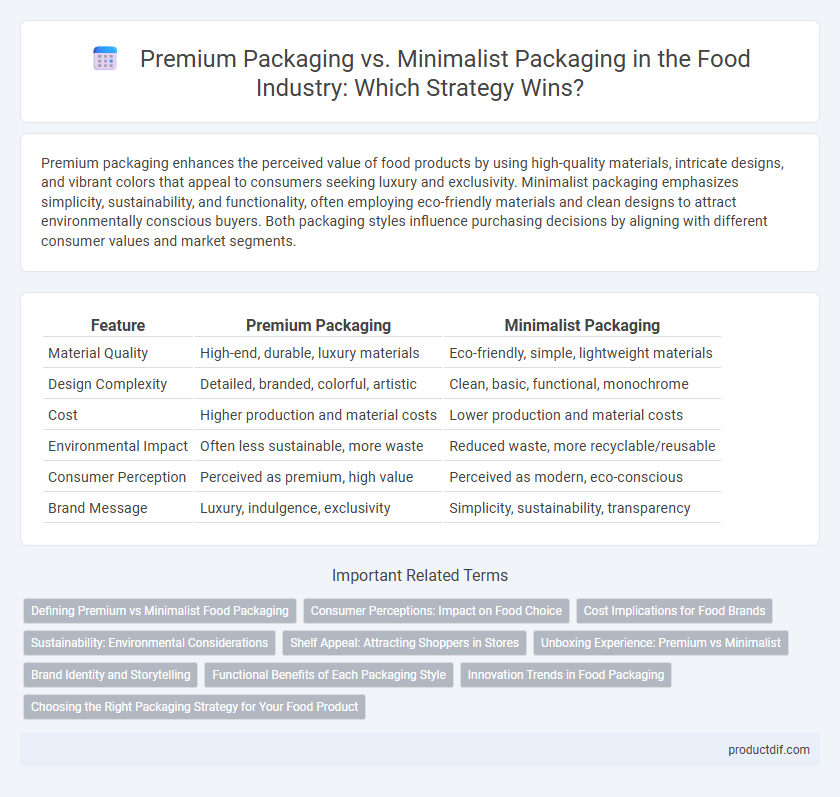Premium packaging enhances the perceived value of food products by using high-quality materials, intricate designs, and vibrant colors that appeal to consumers seeking luxury and exclusivity. Minimalist packaging emphasizes simplicity, sustainability, and functionality, often employing eco-friendly materials and clean designs to attract environmentally conscious buyers. Both packaging styles influence purchasing decisions by aligning with different consumer values and market segments.
Table of Comparison
| Feature | Premium Packaging | Minimalist Packaging |
|---|---|---|
| Material Quality | High-end, durable, luxury materials | Eco-friendly, simple, lightweight materials |
| Design Complexity | Detailed, branded, colorful, artistic | Clean, basic, functional, monochrome |
| Cost | Higher production and material costs | Lower production and material costs |
| Environmental Impact | Often less sustainable, more waste | Reduced waste, more recyclable/reusable |
| Consumer Perception | Perceived as premium, high value | Perceived as modern, eco-conscious |
| Brand Message | Luxury, indulgence, exclusivity | Simplicity, sustainability, transparency |
Defining Premium vs Minimalist Food Packaging
Premium food packaging emphasizes high-quality materials, intricate designs, and luxurious finishes to convey exclusivity and elevate brand perception. Minimalist packaging focuses on simplicity, clean lines, and functionality, often using fewer materials to highlight the product's natural qualities and eco-friendliness. Defining the distinction involves assessing the brand's target audience, sustainability goals, and desired emotional impact through visual and tactile elements.
Consumer Perceptions: Impact on Food Choice
Premium packaging with high-quality materials, intricate designs, and vibrant colors often enhances perceived product value and quality, influencing consumers to associate these foods with luxury and exclusivity. Minimalist packaging, characterized by simplicity, clean lines, and eco-friendly materials, appeals to environmentally conscious consumers seeking transparency and authenticity in food choices. Consumer perceptions shaped by these packaging styles significantly impact purchasing decisions, with premium packaging driving impulse buys and minimalist packaging fostering brand trust and loyalty.
Cost Implications for Food Brands
Premium packaging significantly increases production costs due to high-quality materials, intricate designs, and enhanced durability, impacting the overall pricing strategy for food brands. Minimalist packaging reduces expenses by using fewer resources, simpler designs, and lighter materials, enabling food brands to lower manufacturing costs and offer competitive pricing. Food brands must balance consumer perception of product value with packaging costs to optimize profit margins and market positioning.
Sustainability: Environmental Considerations
Premium packaging often uses multiple layers and non-recyclable materials, increasing environmental impact through greater waste and resource consumption. Minimalist packaging employs fewer materials, prioritizing recyclability and biodegradability, which significantly reduces landfill contributions and carbon footprint. Sustainable food packaging trends favor minimalist designs to support circular economy goals and decrease pollution in ecosystems.
Shelf Appeal: Attracting Shoppers in Stores
Premium packaging uses high-quality materials, intricate designs, and vibrant colors to create a luxurious and eye-catching shelf appeal that attracts shoppers seeking exclusivity and quality. Minimalist packaging relies on clean lines, simple typography, and a restrained color palette to convey elegance and sophistication, appealing to consumers who prefer modern and eco-friendly aesthetics. Both approaches influence consumer perception and purchasing decisions by aligning packaging style with brand identity and target market preferences.
Unboxing Experience: Premium vs Minimalist
Premium packaging elevates the unboxing experience by incorporating high-quality materials, intricate designs, and tactile elements that engage multiple senses, creating a sense of luxury and anticipation. Minimalist packaging emphasizes simplicity and functionality, offering a clean, clutter-free reveal that highlights the product itself while reducing environmental impact. The contrast lies in premium packaging's focus on indulgence and wow factor versus minimalist packaging's prioritization of sustainability and straightforward elegance.
Brand Identity and Storytelling
Premium packaging enhances brand identity by conveying luxury, quality, and attention to detail, creating a memorable unboxing experience that supports storytelling through rich visuals and tactile elements. Minimalist packaging emphasizes simplicity and sustainability, aligning brand values with eco-conscious consumers and communicating authenticity and clarity in the brand story. Both approaches influence consumer perception, with premium packaging often appealing to high-end markets while minimalist design resonates with modern, conscious lifestyles.
Functional Benefits of Each Packaging Style
Premium packaging offers enhanced protection, superior insulation, and extended shelf life for food products, ensuring freshness and reducing spoilage. Minimalist packaging emphasizes eco-friendly materials, ease of recycling, and reduced waste, promoting sustainability and convenience for consumers. Both styles optimize functionality by balancing product safety with user experience and environmental impact.
Innovation Trends in Food Packaging
Innovation trends in food packaging emphasize sustainability and consumer engagement, where premium packaging utilizes advanced materials like biodegradable films and smart sensors to enhance product freshness and experience. Minimalist packaging trends focus on reducing waste through eco-friendly, recyclable designs that strip away non-essential elements while maintaining functionality. Both approaches reflect evolving consumer demands for transparency, environmental responsibility, and convenience in food packaging solutions.
Choosing the Right Packaging Strategy for Your Food Product
Selecting the right packaging strategy for your food product depends on target audience preferences, brand positioning, and product shelf life requirements. Premium packaging often involves high-quality materials, intricate designs, and added protective features to enhance perceived value and preserve freshness. Minimalist packaging prioritizes sustainability, cost-effectiveness, and simplicity, appealing to eco-conscious consumers while reducing environmental impact.
Premium Packaging vs Minimalist Packaging Infographic

 productdif.com
productdif.com